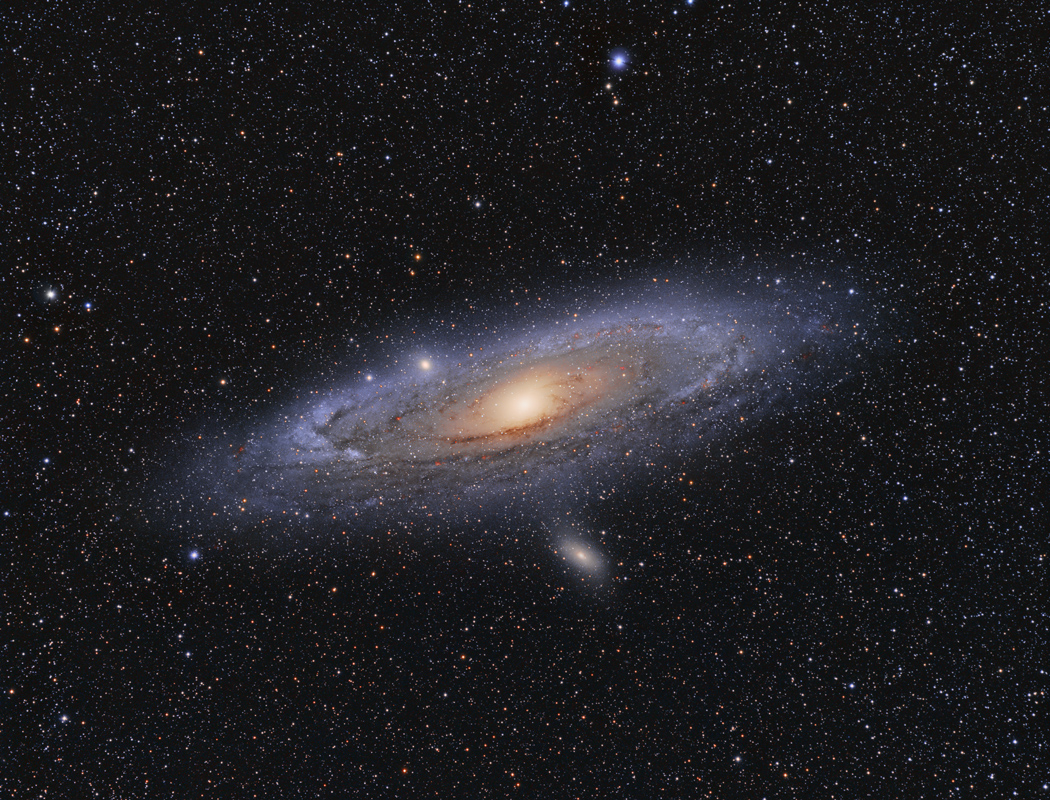The Great Andromeda Galaxy (M31) and Neighbors
Characteristics:
Magnitude: 4.5
Size: 2.1 degrees
FOV: 2.6 x 3.9 degrees
Distance:
2.5 million light years
RA (Jnow): 0h 42m 36s
Dec (Jnow): +41 degrees 16' 38"
Position Angle: +74 degrees
Description:
The Great Andromeda Galaxy is the most prominent member of our local
group, which includes the large and small Magellanic Clouds, M33
(Pinwheel Galaxy), and the neighboring elliptical galaxies M110 and
M32, seen above at 5 o'clock and 10 o'clock (just off center),
respectively. This image represents a total 16 hours of exposure
and is comprised of data from Luminance, Ha, and RGB filters (details
below). The Ha signal is particularly interesting, since it
highlights the bright HII regions most prominent in the outer galactic
arms. HII emission in galaxies is most often due to excitation of
surrounding hydrogen gas by UV irradiation emitted by newly-formed,
young stars. That's why we see so much HII emission in our own
galaxy in regions such as the Orion Nebula and in Cygnus, for
instance. Notice how the HII emission in the above image
corresponds to regions of blue star formation.
The
southwestern arm in the lower left contains a particularly active
region of new star formation referred to as NGC 206, shown in this image
by Rob Gendler. In
my image, notice the absence of prominent HII emission
in the two elliptical galaxies, M110 and M32, which contain old stars
and lack regions of new star formation (it is possible that HII regions
exist in these galaxies as well but are simply below the level of
resolution in this image).
M31, like most large spirals, is thought to contain a large, central
black hole that consumes gas and nearby stars at a prodigious
rate. The radiation emitted in the vicinity of black holes (due
to extreme heating of matter as it flows into the region) compresses
surrounding gas and most likely triggers a new wave of star formation
in a disk surrounding the galactic center. In this regard, there
is a rotating disk of about 400 blue stars that formed 200 million
years ago and is rotating around the galactic center at an orbital
velocity of 2.2 million miles per hour (the details may be found in Rob
Gendler's excellent
description of the M31 nucleus). Given the proximity of these
star to the intense radiation emitted from the central black hole, it
would be impossible for life as we know it to evolve around such
stars. It is predictable that we exist in an outer arm
of a spiral galaxy, where conditions are more favorable for life to
evolve (i.e., the galactic habitable zone). Perhaps intelligent
lifeforms are pondering the same
things about us, as they gaze at the Milky Way from their vantage point
in one of the outer arms of M31.
At a dark site, M31 is a naked eye object, although
for city and
suburban dwellers it's almost impossible to view without a telescope.
The
central portion glows slightly yellow as a result of older stars,
whereas
the periphery has a characteristic bluish hue due to a predominance of
younger stars. Please
check out the higher
resolution links for more detail.
Photographic Details:
Dates: October 20 and 21,
2012
Scope: Takahashi
FSQ106 at f5 on the Takahashi NJP
Mount
Autoguider: SBIG ST-402 with
60mm guidescope, focal length 227mm
Camera: Apogee U16M at -20C, with
7 position 50mm square filter wheel (Apogee FW50-7S)
Filters: Baader
Ha narrowband
filter; Baader LRGB filters
Exposures: Ha, 4 hours; Lum, 4 hours, R, 3 hours;
G, 2 hours; B, 3 hours, all unbinned.
Total
exposure 16 hours.
Post-processing:
Calibrated, aligned and
stacked in Maxim, followed
by DDP
in ImagesPlus (IP). Further processing in Photoshop CS5
Please
note: Graphics on this website may not be reproduced without
author permission.
Back to Galaxies
Home

